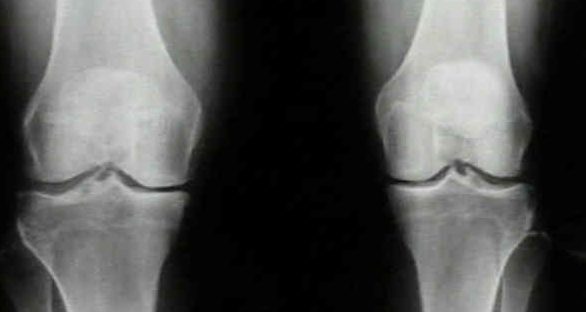
19 Oct Guest Blog – An Introduction to Knee Pain
We are lucky for this blog to have a guest helping to outline some common knee problems that cause pain and difficulty for many patients we see! Let us hand over to Mathew Foster from kneesafe.com:
Types of Knee Pain: An Overview
Knee pain is a common ailment, as your knee joints are a complex and intricate structure containing any number of components that can be damaged by overuse, stretching, or just wear and tear caused by ageing. In this article, we look at the main types of knee pain and what causes them. We will do so by grouping them into four categories of lateral, medial, anterior or posterior knee pain.
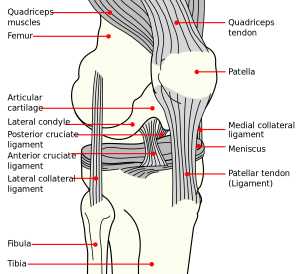
The main ligaments of the knee secure it side-to-side, and deep between the main bones. The patella and its connections control the front of the knee. (Click for a larger view)
Medial knee pain
This is pain that takes place on the inside of your knee. Medial knee pain can result from a number of common problems, some of these are:
- Medial Collateral Ligament (MCL) injuries: sprains or tears to this pivotal ligament, which runs up the inner side of your knee and serves to stabilize the inside of the knee, tend to occur when a strong, sudden force is applied to your outer knee. Besides pain in the medial region of your knee, if you suffer a sprain or tear to your MCL, you might also experience swelling, knee locking, and general instability.
- Medial Meniscus tears: the medial meniscus can be torn when a sudden twisting motion or severe force is applied to the knee. It can also result from normal ageing and wear and tear. Symptoms include pain in the inner region of your knee, swelling, and general instability. With this type of tear, you might find it difficult to straighten out (extend) your knee, and it might even get locked into position.
- Pes Anserine bursitis: this bursa (a fluid-filled membrane that helps reduce friction and rubbing) is located on the inside of your knee near the top of the shinbone. Pes anserine bursitis occurs when the bursa becomes irritated and inflamed due to friction. It will produce too much fluid and become swollen and painful.
Lateral knee pain
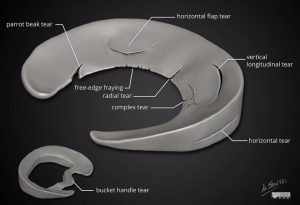
Meniscus tears can be tricky clinically. Depending on the type of tear, they can either remain asymptomatic or cause a serious hindrance to activity. (Click for a larger view).
This occurs on the outer part of your knee, and can also have a number of different causes. Some of these are:
- Lateral Collateral Ligament (LCL) injuries, usually caused by a sudden twisting motion that causes the LCL to stretch or tear. LCL injuries generally result in pain to the affected area, swelling and stiffness.
- Lateral Meniscus tear: another lateral knee injury that results from a sudden twisting motion or heavy force being applied to the knee. Like a medial meniscus tear, it can also result from the normal processes of ageing and wear and tear. Similar to a medial meniscus tear, a lateral meniscus injury can cause swelling, locking of the knee, and overall instability.
- Iliotibial Band Syndrome (ITBS) is another common type of lateral knee injury, often found amongst cyclists and runners. Unlike an LCL injury, this type of knee pain and its associated inflammation typically develops gradually – it is an injury of overuse, not due to a sudden force or twisting movement being applied to the knee. It is most pronounced when engaging in any strenuous activity and often requires rehabilitation to correct the underlying causes.
Anterior knee pain
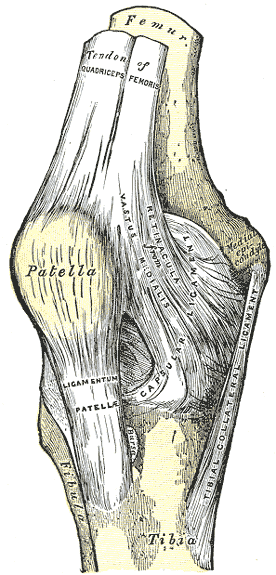
The Patella is held in place by strong ligaments and muscles. Muscles tend to be the villains, and ligaments the victims!
There are many conditions that can cause you to experience pain at the front of your knee. Most often, anterior knee pain has to do with your kneecap (patella), or the patella tendon that is connected to it. Let’s look at some of the issues that can occur in this region of your knee:
- Patellofemoral Pain Syndrome (PFPS), also known as runner’s knee, is a condition in which you experience pain at the front of your knee around the patella. It most commonly results from overuse, such as running too often, perhaps on hard surfaces. Pain is caused by the rear surface of the patella rubbing against your femur (thigh bone). If you suffer from this condition, you might need to adopt measures to stabilize your knee-cap using a knee brace or by doing corrective exercises.
- Chondromalacia Patella is a similar condition to PFPS, but occurs most commonly in teenage girls, and involves the cartilage behind the patella softening, making it easier to damage. The condition is overall similar to PFPS, but also requires the cartilage to become less soft as the patient ages.
- Jumper’s Knee, or, to use the scientific term, Patellar Tendonitis, is another common cause of anterior knee pain. With this condition, you experience pain in the front of your knee, just below the kneecap. The cause? Well, the name says it all. When you jump and leap too often, this places excessive strain on the patellar tendon that connects the kneecap to the shinbone (tibia) and results in inflammation, and pain. Again, this is more an injury of overuse than an impact injury. And again, in order to treat this condition, you will need to engage in some rehabilitation exercises and perhaps wear a knee brace for a certain period of time – a ‘patellar strap’ is one such option.
Posterior knee pain
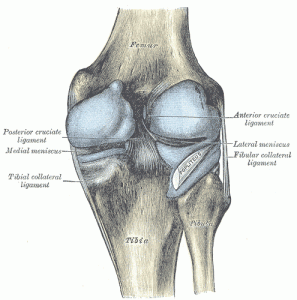
The back of the knee can be complicated clinically. Here you can see the collateral ligaments, and the cruciate ligaments passing inside between the bones of the knee.
Finally, you can also suffer pain behind your knee joint, in what’s called the popliteal region. Let’s look at some of the causes of this type of pain.
- Popliteal or Baker’s Cyst: this is where you develop a large, swollen bulge on the back of your knee. It is caused most often by arthritis or torn cartilage and is really an example of bursitis – a swelling of the fluid-filled bursa that protects the posterior knee from friction.
- Hamstring Injury, such as a tendinopathy to bicep femoris: this is another injury at the back of your knee, generally caused by overuse. The hamstrings connect just below your knee joint line, and injuries to them are very common among professional athletes.
- There are other, less common conditions that cause posterior knee pain, such as Gastrocnemius tendonitis, popliteal bursitis, and posterolateral corner injuries.
And Don’t Forget…
No blog about knee injuries would be complete without:
- Cruciate Ligament injuries are common with football and other sports where there is a lot of running, twisting and turning. The anterior and posterior cruciate ligaments (ACL and PCL) hold the femur (thigh bone) to the tibia (shin bone), preventing them from sliding forwards or backwards on each other. The onset is usually traumatic, the swelling quick to develop, and the knee is typically left unstable afterwards, often requiring a surgical repair.
We hope you find this article a useful guide to some of the different types of knee pain that can occur, and their different causes. It goes without saying, however, that this is only a guide. If you have suffered an injury to your knee, and want a proper diagnosis, then please always make an appointment with a suitably qualified practitioner, such as the team at OpenHealth.
There we go! Huge thanks to Mathew for his guided tour of some of the many knee injuries that can occur! If you think that any of these conditions sound familiar to you or someone else, our advice is always to have the problem assessed sooner rather than later. Especially with knees, good advice about which activities to do or avoid, as well as guidance regarding corrective exercises and stretches, can help prevent a worsening situation.
Toby is an osteopath at OpenHealth, and regularly contributes to our blogs.



No Comments